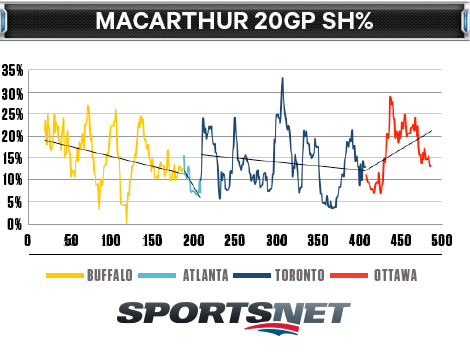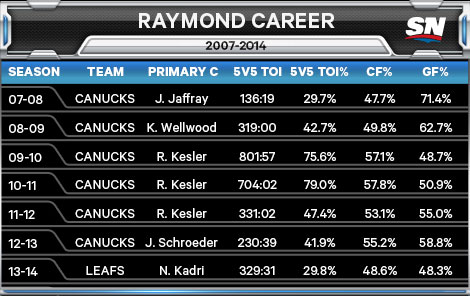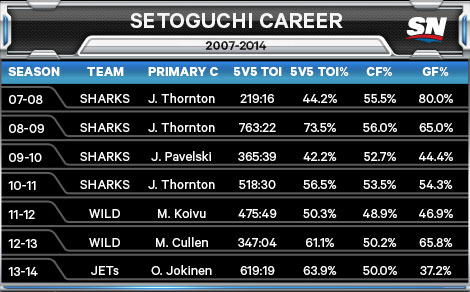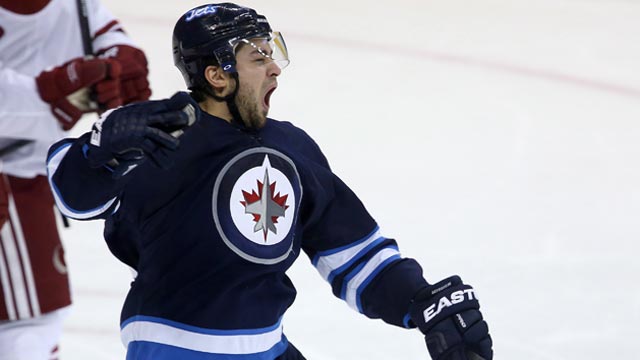Clarke MacArthur, Mason Raymond and Devin Setoguchi. Three wingers in their late 20s, signed in recent seasons by NHL teams looking in the bargain bin for some scoring punch on their second lines.
MacArthur remains the gold standard. He joined the Toronto Maple Leafs in late August of 2010 following a tough go around that season. A deadline acquisition by Atlanta, he was coming off of a $1.4-million contract but hadn’t impressed with his three goals and nine points in 21 games to close out the season.
Heading to arbitration, MacArthur’s camp took the typical tack of aiming high—$2.4 million after a 35-point season. The Thrashers didn’t even contest it, they just walked, leaving MacArthur a UFA. The Leafs signed him for one season at $1.1 million. Somehow a winger with decent offensive upside had been jettisoned due to a rough patch, and washed ashore in Toronto at a discount. In real terms, he took at 21-percent pay cut—54 percent from his arbitration ask.
In Atlanta, MacArthur had primarily skated alongside Rich Peverley and Brian Little, but he only scored on 10 percent of his 30 shots and averaged just 1.43 shots per game. Everywhere else he’s posted a 12.4 percent SH% or better, and averaged at least 1.52 shots per game. If MacArthur had shot 12.4 percent on 1.52 shots per game in Atlanta he would have scored just one more goal, but the numbers might not have looked quite so bad.

MacArthur moved on to form an integral part of a very productive trio alongside Mikhail Grabovski and Nikolai Kulemin in Toronto, scoring 21 goals and 62 points in 82 games and averaging more than 17 minutes a night. More significantly, he also demonstrated very solid possession skills, generating some of the best shot-differential impacts in the entire NHL.
MacArthur has consistently posted some of the top delta Corsi results in the NHL the past seven years (dCorsi is the difference between Observed Shot Attempt Differential and Expected Shot Attempt Differential). He finished second in the league in dCorsi in 2010-11 (Grabovski was first), and the trio buzz-sawed their way through the majority of NHL second units.
Fast forward a few years and MacArthur has just inked a five-year contract to stay in Ottawa through the remainder of his prime producing seasons at a reasonable cap hit of $4.65 million.

As a 24-year-old in 2009-10, Mason Raymond posted a 25-goal, 53-point season and seemed destined for big things. Then injuries—fractured vertebrae, a broken thumb, a significant knee injury—took their toll and he scuffled through 39-, 22-, and 20-point campaigns of varying lengths and struggled to maintain a spot in the Canucks’ top six.
He took a 10 percent pay cut with the Canucks in 2012-13, but after another year of struggles, found himself at Leafs camp on a professional tryout. He inked a one-year, $1-million deal and saw his salary reduced by more than 56 percent. Raymond was basically playing for his career last season, and it just might have worked—he seems to be in the midst of a reboot similar to MacArthur’s. A look at who he primarily lined up with sheds some light on what happened:

Raymond posted a very respectable 19 goals and 45 points in his first 82-game season since his 53-point career-best showing in 2009-10. He also matched his career high in ice time—averaging more than 17 minutes—and provided a positive impact on possession for the first time in three years after posting significantly positive dCorsi ratings during his best days with the Canucks.
Raymond’s top-six ice time came largely at the expense of the Leafs’ largest off-season mistake—David Clarkson and his untradeable contract. But it appears Toronto is determined to recoup some value there and will likely force feed Clarkson top-six minutes. The Leafs weren’t planning on giving Raymond more money or more ice time, and he was locked-up on the first day of free agency by the Calgary Flames for $3.15 million a season for the next three years.

There are some differences, but the Flames are hoping Devin Setoguchi is the next MacArthur or Raymond.
Setoguchi’s contract is cheaper than either “bargain” deal discussed thus far. At one-year and $750,000 (a massive 75-percent pay cut), he will make very little impact on Calgary’s payroll should his production continue to disappoint. The other sizable distinction for Setoguchi compared to MacArthur or Raymond is that hisis dCorsi has only been positive once in the past seven seasons, though this isn’t an area of particular weakness for the Flames.

Where Setoguchi could make a difference with his new team is as a shooter. For his career in San Jose and Minnesota (his first two NHL teams), he scored on 11.7 percent of his shots. Last year with the Jet,s he was an 8.5-percent shooter.

It is unlikely a player who shoots 11.7 percent his first 986 shots suddenly forgets how to score. And Setoguchi has done this before. From games 152 to 253 of his career, Setoguchi scored on 9.3 percent of his shots before seeing his touch return—to an 11.7 SH%—for the next 185 games of his career in San Jose and Minnesota prior to his arrival in Winnipeg.
If Setoguchi slots in as a second-liner for the Flames and can average around 16 minutes a night with some power-play time, it’s likely his SH% rebounds this season. More problematic is his decline in shot generation. If we take a look at his rate of shots per 60 minutes of 5v5 TOI during his career, a trend emerges:

If Setoguchi can’t generate more than seven shots per 60 minutes of 5v5 TOI, he won’t be able to generate goals and points at a rate over 0.25 and 0.5 per game, as he managed earlier in his career. All of this being said, it’s important to note which centres Setoguchi has primarily lined up alongside in his seven seasons:

I would suggest that Setoguchi likely gets to line up alongside Mikael Backlund or Matt Stajan early in an effort to spark some output. Both Calgary pivots likely represent a possession upgrade on Olli Jokinen, but the real question will be if Setoguchi’s shot rate can improve as his SH% bounces back.
Even if his shot rate continues to drop, ending up around 6.5 shots per 60 mins of 5v5 TOI, a rebound to 9 percent shooting at 5v5 paired with power-play numbers of about 11 shots per 60 mins of 5v4 TOI and 12 percent shooting would translate to roughly 14 goals in 72 games, or 0.19 goals per game. Fourteen goals for $750,000 is reasonable production, though not quite the steal some Flames fans might be hoping for.
If people expect Devin Setoguchi to become the latest edition of the NHL “UFA bargain bin find” he’s going to need score more and play more—two factors not entirely under his control and in many ways depend on who he is playing with. But he can control his shot rate, and if he isn’t shooting enough there’s no way he becomes the next MacArthur or Raymond.

